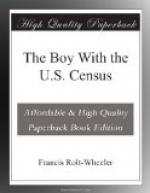As much surprised as gratified at the excellent arrangements for his comfort, Hamilton refreshed himself after his dusty ride, and was as hungry as a wolf when supper arrived. A little darky girl, black as the ace of spades, waited at table, and in conversation Hamilton learned that she was the adopted daughter of the eldest son of the negro preacher, the son being a professor in one of the negro colleges. After supper Hamilton asked to see his host in order that he might secure the details of the family for the census, and thus make use of a disengaged evening.
“So your son is Professor of English at the University,” said Hamilton, as, with all the details secured, he closed the census portfolio. “Do, you think the negro ought only to learn a few things, or do you think he ought to be taught just the same as in the regular universities?”
“Thar should be one good university,” said the old preacher, “with very difficult admission examinations. It would be a good thing fo’ colored lawyers an’ doctors, an’ if the standard were high—higher even than in white colleges—these men would get standin’ fo’ themselves an’ give standin’ to the colored race. But, even then, I’d have them keep away f’om the other lawyers an’ doctors.”
“You’re strong on that color line, Ephraim,” the boy remarked. “Surely you don’t believe in ‘Jim Crow’ cars and all that sort of thing?”
“As long as thar is prejudice, Ah do,” was the unexpected answer, “an’ thar’s no place fo’ the negro in the city. He can’t beat the white man, an’ thar’s no chance o’ his securin’ a monopoly o’ any trade. Thar’s nothin’ fo’ him in the city savin’ jes’ labor an’ bein’ a servant, a porter, or somethin’ o’ that kind.”
“You don’t see many negro laborers in Northern cities,” the boy remarked, “they’re mostly elevator runners and in positions of that kind.”
“It is in the No’th that trouble lies,” the old man said, “the South has settled hers.”
“How do you make that out?” cried the boy. “You say the South has settled the race question? I thought it was the biggest issue there was, down here and in the Gulf States.”
The old negro preacher shook his head.
“Farmin’ an’ cotton raisin’ has settled it. Did yo’ know that mo’ than two-fifths, or nearly half the cotton raised in the United States was grown by negroes ownin’ their own land? An’ the cotton crop of America’s one of her biggest sources o’ wealth. Those that don’ own the land lease it on a share basis known as the metayer system, but more’n more o’ them are owners every year.”
“I hadn’t really thought of the negroes as owning land at all,” said Hamilton thoughtfully.
“A stretch o’ land three times as big as the British Isles, or equal to the New England States is owned by the colored race,” was the reply, “makin’ in the United States a negro country larger than plenty o’ kingdoms.”
“And is that land worth much?”




